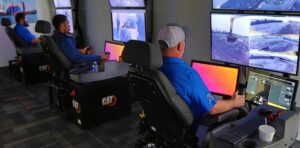
Layers of potential
By MATT WILLIAMS
Construction Equipment Equipment Technology Labour Skills DevelopmentAdvancements in remote technology are increasing safety while creating new opportunities for diversity.
If you’re running a construction site today, safety, productivity and sustainability are probably three key priorities where technology is helping you stay ahead of the game, but new and emerging technologies, including remote-operation stations, hold much promise on the human resource front as well. These digital systems can help support diversity and inclusion initiatives in the construction industry which, in turn, can help offset labour shortages.
As remote technology advances for machinery operation, an emerging concept is the ability to move operators fully off-site. Remote-operator stations completely replicate the cab environment and provide multiple video feeds for a steady stream of data, as if the operator were operating the equipment right on-site Onboard electronic and visual systems even allow several machines to be controlled remotely at once.
Still new to the construction sector, remote operation has proven itself in heavy equipment applications like mining, so the technology is now gaining ground for the construction industry as well.
The safety benefits from these stations are significant as operators are completely removed from hazardous areas. Productivity gains are also substantial as operators can control more than one piece of equipment at a time.
While safety and productivity are important benefits, the industry also has the opportunity to harness the technology to help with the additional priorities of diversity and inclusion.
Worker retirements, skills gaps and overall labour shortages are big challenges ahead for the construction sector. BuildForce says Canada’s construction industry needs 309,000 new workers by 2030.
Tapping into a wider talent pool of skilled workers will be an important component of remaining competitive, safe and productive, and this technology holds potential to attract workers who may have not have considered a job on an active construction site.
For people with disabilities, remote operation opens new opportunities. Operator stations remove the barriers found on a traditional jobsite, including having to maneuver through muddy, rocky or uneven terrain to sit in a machine. Climate-controlled, safe and comfortable, the consoles increase longevity for all operators, reducing issues associated with machine vibration, dust and noise.
Remote operation also has the potential to support Indigenous communities with the technology holding potential to provide new employment opportunities as remote operating stations can be installed within communities to help remove barriers like the need to travel far or move away for work opportunities.
Although these modern devices may sound like the perfect solution to the construction industry’s problems, no technology can solve all problems immediately.
Making the shift to remote applications is a complex undertaking, particularly in isolated locations. The infrastructure needed for connectivity has been a barrier to wider adoption. And we’ve learned from early implementers that the biggest challenge isn’t the technology itself but the impact it has on people and process. A significant amount of time needs to be spent on change management.
Successfully implementation of remote technology holds significant potential to help the construction industry, however.
Matt Williams is the technology platform specialist for CAT Command at Finning Canada.





